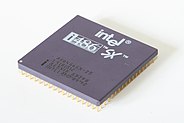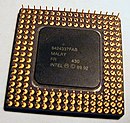i486SX
 From Wikipedia the free encyclopedia
From Wikipedia the free encyclopedia
The i486SX was a microprocessor originally released by Intel in 1991. It was a modified Intel i486DX microprocessor with its floating-point unit (FPU) disabled. It was intended as a lower-cost CPU for use in low-end systems—selling for US$258—adapting the SX suffix of the earlier i386SX in order to connote a lower-cost option. However, unlike the i386SX, which had a 16-bit external data bus and a 24-bit external address bus (compared to the fully 32-bit i386DX, its higher-cost counterpoint), the i486SX was entirely 32-bit.[1]: 117
Overview[edit]
In the early 1990s, common applications, such as word processors and database applications, did not need or benefit from a floating-point unit, such as that included in the i486, introduced in 1989. Among the rare exceptions were CAD applications, which could often simulate floating point operations in software, but benefited from a hardware floating point unit immensely.[2] AMD had begun manufacturing its i386DX clone, the Am386, which was faster than Intel's.[3] To respond to this new situation, Intel wanted to provide a lower cost i486 CPU for system integrators, but without sacrificing the better profit margins of a full i486. Intel were able to accomplish this with the i486SX, the first revisions of which were practically identical to the i486 but with its floating-point unit internally wired to be disabled.[1]: 116–117 [4]: 162–164 [a] The i486SX was introduced in mid-1991 at 20 MHz, one core with 8kb of cache in a pin grid array (PGA) package.[2] Later versions of the i486SX, from 1992 onward, had the FPU entirely removed for cost-cutting reasons and comes in surface-mount packages as well.[1]: 117
The first computer system to ship with an i486SX on its motherboard from the factory was Advanced Logic Research's Business VEISA 486/20SX in April 1991.[6] Initial reviews of the i486SX chip were generally poor among technology publications and the buying public, who deemed it an example of crippleware.[1]: 117
Many systems allowed the user to upgrade the i486SX to a CPU with the FPU enabled. The upgrade was shipped as the i487, which was a full-blown i486DX chip with an extra pin. The extra pin prevents the chip from being installed incorrectly.[b] Although i486SX devices were not used at all when the i487 was installed, they were hard to remove because the i486SX was typically installed in non-ZIF sockets or in a plastic package that was surface mounted on the motherboard. Later OverDrive processors also plugged into the socket and offered performance enhancements as well.[7]
Explanatory notes[edit]
- ^ A long-standing rumor was that the first batches of the i486SX were i486 chips with defective floating-point units on their dies. However, Alex Witkowski, Intel alumnus and an engineer behind the i486SX, rejected this on the OS/2 Museum blog, writing that the floating-point units of the original i486 chip die to be converted to i486SX were never tested, and that only by grounding a certain bond wire in the CPU package was this conversion accomplished.[5]
- ^ The NC# pin (one of the standard 168 pins of the i486) was used to shut off the i486SX.[5]
References[edit]
- ^ a b c d Ross, Matthew J. (October 13, 1992). "486SX: The New Entry-Level PC". PC Magazine. 11 (17). Ziff-Davis: 114–257.
- ^ a b Slater, Michael (July 1991). "The new entry-level platform: Intel aims 486SX to gradually replace 386DX". Computer Shopper. 11 (7). SX2 Media Labs: 113 – via Gale.
- ^ Caron, Jeremiah (May 20, 1991). "More punch per dollar spent". Computerworld. XXV (20). IDG Publications: 104 – via Google Books.
- ^ Seymour, Jim (December 31, 1991). "486SX: Great for Intel, but What About You?". PC Magazine. 10 (22). Ziff-Davis: 170–238 – via Google Books.
- ^ a b Necasek, Michal (December 26, 2015). "Lies, Damn Lies, and Wikipedia". OS/2 Museum. Retrieved December 27, 2015.
- ^ Lavin, Paul (April 24, 1991). "World's first 486SX". PC User (157). EMAP Media: 33 – via Gale.
- ^ "Microprocessor Types and Specifications". InformIT. Pearson. June 8, 2001. Archived from the original on December 7, 2021.
External links[edit]
- Intel 80486SX images and descriptions at cpu-collection.de
- Intel datasheets



